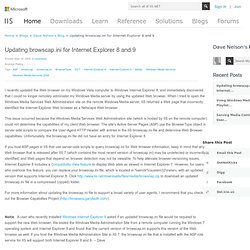

ASP.NET.4GuysFromRolla.com: Performing Browser Detection Using A. By Scott Mitchell Introduction When the browser wars were at their height from 1996-1999, or so, browser detection was an important facet of Web design. During these years, the features supported by Microsoft and Netscape varied quite a bit, and Web designers who wanted to make use some of the "cooler" features of a given browser would need to detect what browser the user was using in order to customize the HTML outputted by the Web page. Many sites actually maintained two sets of pages: one for Netscape and one for Internet Explorer, and the main page would redirect the user to the applicable set of Web pages based on the user's browser.
To accomplish this, Web designers used what is known as browser detection. Updating browscap.ini for Internet Explorer 8 : Dave Nelson's Bl. I recently updated the Web browser on my Windows Vista computer to Windows Internet Explorer 8, and immediately discovered that I could no longer remotely administer my Windows Media server by using the updated Web browser.

When I tried to open the Windows Media Services Web Administration site on the remote Windows Media server, IIS returned a Web page that incorrectly identified the Internet Explorer Web browser as a Netscape Web browser. This issue occurred because the Windows Media Services Web Administration site (which is hosted by IIS on the remote computer) could not determine the capabilities of my client Web browser. The site's Active Server Pages (ASP) use the BrowserType object in server-side scripts to compare the User-Agent HTTP Header with entries in the IIS browscap.ini file and determine Web Browser capabilities.
Unfortunately, the browscap.ini file did not have an entry for Internet Explorer 8.